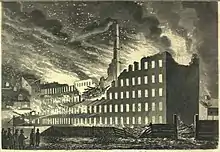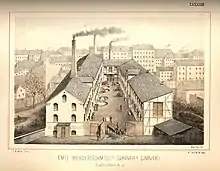| Gammel Kongevej 25 | |
|---|---|
.jpg.webp) Gammel Kongevej 25 in December 2020 | |
| General information | |
| Location | Copenhagen |
| Country | Denmark |
| Coordinates | 55°40′25″N 12°33′21″E / 55.67353°N 12.55586°E |
| Completed | 1867/1869 |
Gammel Kongevej 25, situated opposite St. Jørgen's Lake, on the border between Vesterbro and Frederiksberg in Copenhagen, Denmark, consists of a five-storey Late Neoclassical residential building fronting the street and the former Emil Messershcmidt's Tannery on its rear'. The three-winged tannery complex is one of relatively few surviving examples of the many minor industrial enterprises that once dominated the courtyards of Copenhagen's Vesterbro and Nørrebro districts. The current buildings were constructed by Emil Messerschmidt after a fire in 1867 and later continued by his two eldest sons until another fire in 1907.
History

The tannery was founded in 1844 by Christian William Messerschmidt (1804-1888), a retired army officer with rank of major.[1] In 1853, he ceded it to his son, Emil Messerschmidt (1828-1877), who moved it to its current location. The large quantities of water that played an essential role in many steps of the production process was sourced directly from Rosenåen, a former moat from the 1620s, which crossed Gammel Kongevej at the site.[2]
On 16 January 1867, Messerschmidt's tannery was hit by fire.[3]

The tannery was already rebuilt the same year. A residential building fronting the street was constructed in 1869 to make the most of the site.
On Emil Messerschmidt's death, it was passed down to his two eldest sons John (born 1855) and Louis Messerschmidt (1858). A younger son, Christian Wilhelm Messerschmidt (1871-1948), would in 1895 start a wholesale company trading in tanines, extracts and leather.[1] He is also remembered for building the country house Christiansgave in Rungsted north of Copenhagen.[4] Louis Messerschmidt was from 1904 to 1916 alderman of the Tanners' Guild in Copenhagen.[5]
In 1907, the tannery was once again hit by fire. The property was the following year acquired by A/S M. I. Ballins Sønner. It was decommissioned as a tannery in around 1920. The buildings were then used as a furniture storage and by minor manufacturing companies.[6]
The building fronting the street was restored by Erik Arkitekter in 2917.[7]
Architecture
The tannery is located three sides of a central courtyard to the rear of the residential building. The eastern side wing is constructed in brick and used to contain the tannery's boiler and machinery. The two other wings are built with timber framing. The ground floor of the western side wing was originally used as stables. The upper floor was used for storing hides and chemicals used in the production. The rear wing was heightened from one to two floors after the fire in 1907.
Commemorative plaque
A commemorative plaque on the facade reads: "INGOLF·LARSEN-LEDET / GAVE HIS LIFE FOR / dENMARK'S fREEDOM / 29 jUNE 1944" ("INGOLF·LARSEN-LEDET / GAV HER SIT LIV FOR / DANMARK'S FRIHED / 29 JUNI 1944"). During the Occupation of Denmark in World War II, Ingolf Larsen-Ledet (1919-1944) was involved in the underground publication De danske Studenter as well as the escape routes out of Copenhagen. He was killed during an attempted escape from the Gestapo when he jumped out of a closed window from one of the apartments.[8]
See also
References
- 1 2 "EMIL MESSERSCHMIDT´s SØNNER" (in Danish). coneliand.dk. Retrieved 16 December 2020.
- ↑ "Messerschmidts Garveri" (in Danish). Kulturministeriet. Retrieved 15 December 2020.
- ↑ "Ildebranden i Messerschmidts garveri" (in Danish). kbhbilleder.dk. Retrieved 16 December 2020.
- ↑ "Hørsholm set fra luften – Christiansgave 1937" (in Danish). Hørsholm Nyheder. Retrieved 16 December 2020.
- ↑ "John Messerschmidt" (in Danish). Dansk Biografisk Leksikon. Retrieved 16 December 2020.
- ↑ "Emil Messerschmidt's Sønners garveri" (in Danish). DTU. Retrieved 16 December 2020.
- ↑ "Gl. Kongevej nr. 25" (in Danish). Wrik Arkitekter. Retrieved 15 December 2020.
- ↑ "Mindetavle for Ingolf Larsen-Ledet" (in Danish). Wrik Københavns Biblioteker. Retrieved 15 December 2020.
External links
- Emil Messerschmidt at geni.com
- Source
- Emil Messerschmidt